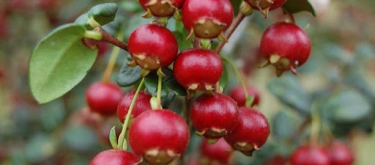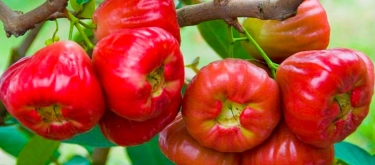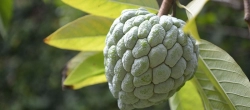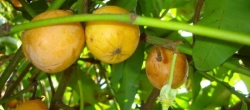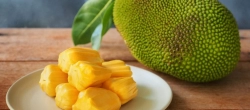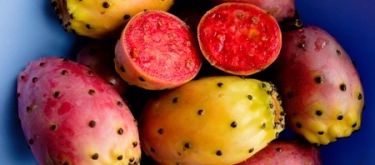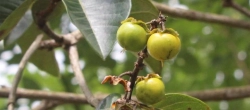Feijoa: Taste Profile, Aroma, Benefits and Health Risks
Feijoa (Acca sellowiana), also known as pineapple guava, is a small tropical fruit native to South America, notably Brazil, Uruguay, and Argentina. Its popularity has expanded globally, particularly in Australia, New Zealand, and parts of the Mediterranean, for its unique flavor, appealing fragrance, and versatile culinary applications. Consumed fresh or transformed into jams, juices, and desserts, feijoa provides an exceptional sensory and nutritional experience.
Feijoa is suitable for vegetarian, vegan, and gluten-free diets. Allergic reactions are uncommon but individuals sensitive to tropical fruits or pollen-related allergies should exercise caution. High iodine content may impact individuals with thyroid conditions.
What does Feijoa taste like?

Complete Sensory Description
Taste
Feijoa exhibits a unique, intricate flavor profile blending sweet and tangy notes with tropical fruit complexity. Its taste is often described as a harmonious fusion of pineapple, guava, strawberry, and pear, with subtle hints of mint and eucalyptus. Sweetness is moderately balanced by mild acidity, producing a refreshing, sophisticated palate experience.
Aroma
The aroma of feijoa is distinctly fragrant, sweetly tropical, and gently herbal. Prominent aromatic notes of pineapple, guava, and strawberry intertwine with refreshing undertones of mint and eucalyptus. This distinctive fragrance intensifies noticeably as the fruit ripens, providing significant culinary appeal.
Texture
The feijoa fruit's flesh is soft, grainy, and juicy, similar in texture to a ripe pear. Slightly gritty due to small edible seeds, its texture offers an appealing sensory contrast, becoming increasingly tender and succulent when fully ripe. The edible skin is thin, slightly firm, and typically consumed along with the flesh, contributing a gentle textural contrast.
Appearance
Feijoas are small, oval-shaped fruits approximately the size of a hen's egg, with dull-green to dark-green waxy skin. The interior flesh varies from translucent white to pale-yellowish, filled with soft, edible seeds forming a distinctive star-shaped pattern when cut crosswise. This attractive appearance contributes to culinary presentations and fresh consumption appeal.
In-depth Flavor Analysis
Feijoa’s uniquely complex flavor results from an interplay between sugars, organic acids, aromatic terpenes, and ester compounds. Natural sugars (fructose and sucrose) establish the fruit's balanced sweetness, complemented by malic acid’s mild, apple-like tartness, enhancing freshness without overpowering sweetness.
Feijoa's distinctive aroma and flavor derive primarily from volatile esters and terpenes, notably ethyl benzoate, ethyl butanoate, methyl benzoate, and cineole (eucalyptol). Ethyl benzoate and ethyl butanoate contribute sweet, fruity, tropical, and berry-like fragrances, while methyl benzoate offers faint floral sweetness. Cineole provides the characteristic minty-eucalyptus undertone, uniquely distinguishing feijoa among tropical fruits.
Flavor intensity and complexity vary significantly depending on ripeness, climatic conditions, and soil type. Fruits ripening under warm, sunny conditions develop richer sweetness and intensified aromatic complexity, while cooler climates yield fruit with enhanced acidity and more prominent herbal freshness.
Varieties and Culinary Applications
Feijoa Varieties
- Apollo: Large, juicy, aromatic, excellent fresh or processed into preserves and desserts.
- Triumph: Medium-sized, sweet-tart flavor, suitable fresh or in jams, chutneys, or beverages.
- Gemini: Small-medium, intensely aromatic, sweet and tangy, ideal for fresh consumption or flavoring desserts.
Culinary Applications
- Fresh Consumption: Eaten fresh, sliced open and scooped directly from the skin.
- Desserts & Baking: Incorporated into cakes, muffins, puddings, tarts, sorbets, ice creams, and fruit salads.
- Preserves & Sauces: Transformed into jams, jellies, chutneys, sauces, or fruit relishes.
- Beverages: Blended into smoothies, juices, cocktails, or flavor-infused waters.
- Savory Uses: Paired with seafood, poultry, cheeses, or incorporated into marinades and vinaigrettes.
Selection and Storage
Selecting Quality Feijoas
- Choose fruits slightly soft to the touch with fragrant, pleasant aromas; avoid overly firm or bruised fruits.
- Optimal ripeness is indicated by fragrance and gentle yield when pressed lightly.
Storage Recommendations
- Ripen feijoas at room temperature. Refrigerate ripe fruit (2–4°C / 35–39°F) to extend freshness for 5–7 days.
- For longer storage, feijoas freeze well; pulp can be scooped and frozen in airtight containers.
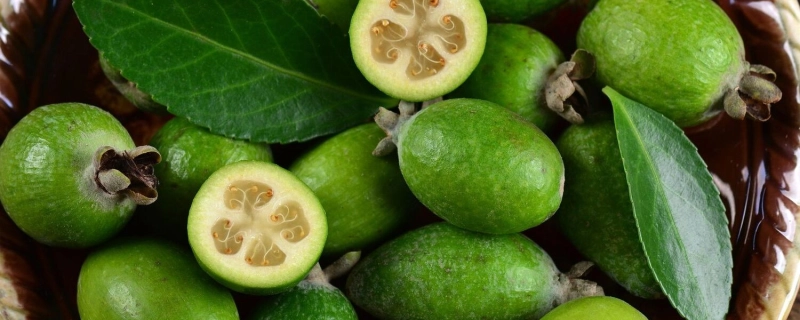
Nutritional Insights
-
Rich in Vitamin C:
Provides excellent vitamin C content, essential for immune function, collagen synthesis, and antioxidant protection. -
Dietary Fiber:
High dietary fiber supports digestion, promotes gut health, aids weight management, and regulates blood sugar levels. -
High in Iodine:
Contains naturally elevated iodine levels beneficial for thyroid health and metabolic regulation, yet requiring moderation in sensitive individuals. -
Antioxidants & Minerals:
Contains flavonoids, polyphenols, potassium, calcium, and magnesium, contributing to cardiovascular health, anti-inflammatory effects, and bone strength.
Expert Insights & Culinary Tips
-
Flavor Pairings:
Feijoa pairs excellently with citrus (lime, lemon), ginger, vanilla, coconut, mint, apples, pears, berries, yogurt, cheeses, seafood, poultry, and pork dishes. -
Maximizing Flavor:
Allow feijoas to fully ripen for optimal sweetness, fragrance, and flavor depth. Overripe fruits, though overly soft, excel in jams or sauces due to intensified sweetness and aroma. -
Balancing Herbal Notes:
Combine feijoas with sweeter fruits, honey, or creamy ingredients (yogurt, coconut milk) to balance minty-herbal undertones and achieve culinary harmony.
Interesting and Curious Facts
- Feijoa is named after João da Silva Feijó, a Portuguese botanist who first documented the fruit in Brazil.
- In New Zealand, feijoas have achieved significant popularity, often referred to affectionately as "the national fruit," widely grown domestically and commercially.
- Feijoa flowers are edible, beautiful, and mildly sweet, occasionally used decoratively in salads, desserts, or gourmet presentations.
Harm and Dietary Considerations
-
High Iodine Content:
Due to iodine levels, individuals with thyroid conditions or iodine sensitivity should consume feijoas in moderation. -
Oral Allergy Syndrome:
Individuals sensitive to pollen, specifically birch pollen, may experience mild allergic symptoms after consuming raw feijoas.
Religious Dietary Considerations
Feijoa is universally acceptable in all major religious dietary traditions:
- Islam: Permissible (Halal).
- Judaism: Permissible (Kosher, Parve).
- Hinduism & Buddhism: Permissible; commonly enjoyed without dietary restrictions.
- Christianity & Other religions: No known dietary restrictions.
Final Thoughts & Sensory Journey
Feijoa captivates with its aromatic complexity, harmonious sweetness, and refreshing herbal undertones. Its unique combination of tropical fruit flavors, appealing fragrance, and nutritional richness has made feijoa a beloved fruit in culinary cultures worldwide, offering remarkable sensory experiences whether fresh, preserved, or creatively incorporated into diverse dishes.
Resources
- Lim, T. K. (2012). Edible Medicinal and Non Medicinal Plants: Volume 4, Fruits. Springer.
- McGee, H. (2004). On Food and Cooking: The Science and Lore of the Kitchen. Scribner.
- USDA FoodData Central (2023). Feijoa Nutritional Composition, Culinary, and Storage Guidelines.

